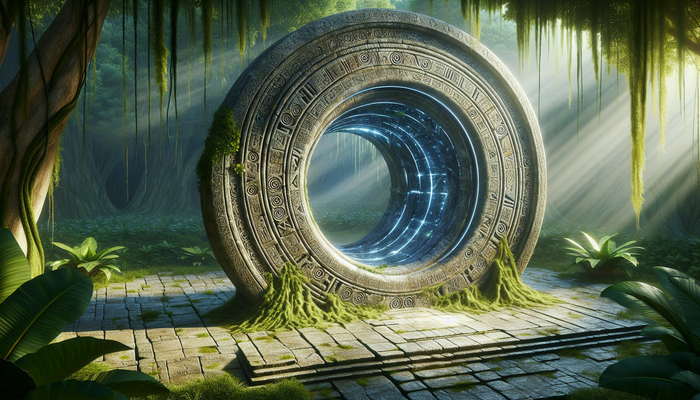Exploring The Dragon Triangle Anomalies

By Amara Okafor, Ufologist
Off the southeastern coast of Japan lies a stretch of the Pacific Ocean that sailors have feared for centuries. Ships disappearing without distress calls, phantom vessels drifting empty under starlit skies, compasses spinning wildly for no apparent reason-these are just a few of the strange occurrences reported in the infamous Dragon Triangle. While the Bermuda Triangle may have captured Western imagination, its Pacific counterpart harbors tales potentially more disturbing and numerous, yet remains surprisingly unknown to many.
When I first began researching this maritime mystery zone, I was struck by the sheer volume of incidents spanning thousands of years. Unlike many modern legends that emerged in the 20th century, the Dragon Triangle's ominous reputation dates back millennia, woven deeply into the cultural fabric of Eastern seafaring nations.
Where Legends Meet the Map: Pinpointing the Dragon Triangle
Trying to define the exact boundaries of the Dragon Triangle is like attempting to capture mist in your hands-it shifts depending on who you ask. Generally, this region stretches across a vast swath of the Pacific Ocean south of Tokyo, encompassing parts of the Philippine Sea. Some define it as a triangle connecting Japan, Taiwan, and Yap Island, while others draw its points from central Japan to Guam and the Mariana Islands.
This ambiguity in its borders perhaps adds to its mystique, creating a fluid zone of danger rather than a precisely mapped hazard. The Japanese call it "Ma no Umi"-a name that translates ominously to "sea of troubles," "troublesome sea," or "dangerous sea." Chinese mariners have their own designation, referring to the "Dragon's Triangle" in reference to ancient beliefs about what lurked beneath those unpredictable waters.
The region has collected names like a ship collects barnacles over time: The Devil's Sea, The Formosa Triangle, and The Pacific Bermuda Triangle. Each name carries its own weight of dread, speaking to generations of fear associated with these waters. Local fishermen would traditionally avoid the area entirely, passing down warnings from father to son about the fate awaiting those who dared traverse it thoughtlessly.
Whispers of the Ancient Waters: Myths and Monsters of Ma no Umi
Long before modern ships equipped with radar and satellite communications reported anomalies, ancient Chinese texts from around 1000 BCE described massive dragons living beneath the waves of what we now call the Dragon Triangle. These weren't benevolent creatures-they were described as having an insatiable hunger, dragging entire vessels down to satisfy their appetite.
"The dragons beneath stir the seas to hunger when vessels pass," reads one ancient account. "Those who enter their domain become food for the eternally famished."
Modern scientists suggest these tales might actually represent early observations of the region's intense volcanic activity. Underwater eruptions creating massive turbulence, plumes of steam rising from the water's surface, sudden whirlpools forming without warning-all could easily appear as the work of a massive, fire-breathing creature to ancient observers. The dragons of legend may have been the Pacific Ring of Fire making itself known in spectacular, terrifying displays.
Japanese folklore adds another dimension with tales of malevolent spirits inhabiting these waters. Their Ma no Umi was a place where supernatural forces ruled supreme, where to enter was to risk never returning. Sailors who survived passages through these waters brought back tales of strange lights hovering over the water, mysterious fogs appearing from nowhere, and eerie sounds emanating from below the waves.
Among the most unsettling legends are accounts of ghost ships. In 1881, the HMS Bacchante reportedly encountered what appeared to be the legendary Flying Dutchman-a phantom ship glowing with an unearthly phosphorescence that vanished as they approached. What makes this particular sighting noteworthy is who recorded it: a naval ensign aboard the Bacchante who would later become King George V of England. The future monarch wrote in the ship's log that the ghost ship "crossed our bows" and "emitted a strange phosphorescent light as of a phantom ship, all aglow" before disappearing without a trace.
More recent accounts include a 1989 report from a Japanese whaling vessel that discovered a small fishing boat drifting aimlessly. When the crew investigated, they found the boat completely empty except for the corpse of the captain still gripping the helm. The rest of the crew had vanished without explanation.
Perhaps the most fascinating pre-modern account is the Utsuro-bune legend from 1803. Multiple independent accounts from different parts of Japan describe Japanese fishermen encountering a strange hollow, round vessel that washed ashore. Inside was a woman unlike any they had seen before-described as having pale skin, round eyes, red eyebrows, and reddish hair with white extensions. She wore clothing made of unknown fabrics and carried a mysterious box she refused to let anyone touch. Unable to communicate with her due to language barriers, the fishermen eventually returned her to her vessel and sent her back to sea.
What makes this legend particularly compelling is that Japan was largely isolated from the outside world at this time, yet strikingly similar drawings of this "hollow ship" and its strange occupant appeared in different regions across Japan. Modern UFO researchers sometimes point to this as one of the earliest documented close encounters, while skeptics suggest it might have been a foreign castaway from a distant land. Whatever the truth, the widespread nature of the accounts suggests something unusual did wash up on Japanese shores in the early 19th century.
Vanished Without a Trace: Modern Mysteries of the Dragon Triangle
While ancient legends might be dismissed as superstition, the Dragon Triangle's ominous reputation continued well into the modern era. Following World War II, reports of disappearances reached such alarming levels that in 1950, Japanese officials formally declared the triangle a danger zone for shipping-an unprecedented acknowledgment of the region's treacherous nature.
Between the 1940s and 1950s, at least five Japanese military vessels reportedly vanished in the area, along with over 700 sailors. These weren't primitive crafts but modern ships with trained crews and communication equipment. Their complete disappearance without distress calls puzzled maritime authorities.
The most famous modern incident-and perhaps the most ironic-occurred in 1952. After numerous vessels had vanished, the Japanese government dispatched a research vessel, the Kaiyo Maru No. 5, specifically to investigate the mysterious disappearances. The ship carried 22 crew members and nine scientists equipped with advanced instruments to study the region.
In a twist that seems almost deliberately cruel, the Kaiyo Maru No. 5 itself vanished without a trace. No distress signal was received. The researchers sent to solve the mystery became part of it. While wreckage was eventually discovered, the fate of the crew remains unknown. This incident cemented the Dragon Triangle's sinister reputation in the public consciousness and led to further restrictions on maritime traffic in the area.
The disappearances weren't limited to the sea. Aircraft have also vanished while flying over the triangle. In 1957, a US Air Force C-97 Stratofreighter carrying 67 military personnel disappeared despite reporting calm conditions and clear skies. A distress signal was never received, and no wreckage was ever found. Similar fates befell a US Air Force F3B jet in 1955 and a KB-50 tanker transport with eight crewmen in 1957.
Even in our era of advanced technology, the mystery continues. In 1980, the MV Derbyshire-one of Britain's largest ships at the time-disappeared in the Dragon Triangle during Typhoon Orchid. Despite its massive size (more than twice that of the Titanic) and modern communication equipment, no distress call was ever received. Similarly, in 2002, the Chinese freighter MV Lin-Je vanished while en route to the Japanese port of Kagoshima, again without any distress message.
What makes these modern disappearances particularly puzzling isn't just that vessels were lost-that can happen anywhere in the world's oceans-but the complete absence of communication or debris in many cases. Ships and planes seemed to simply vanish as if they'd never existed at all.
Encounters with the Unexplained: Strange Experiences in the Dragon Triangle
Not all who venture into the Dragon Triangle disappear. Some return with tales of bizarre phenomena that defy conventional explanation. These first-hand accounts, coming from experienced mariners and pilots, add another layer to the region's mystery.
Many report seeing strange lights hovering over or emerging from the water. These aren't distant flashes or easily explained atmospheric effects, but sustained, clearly visible phenomena that move in ways that seem intelligent and purposeful. Fishermen describe glowing orbs that follow their vessels, sometimes for hours, before suddenly plunging into the depths or shooting upward into the sky.
"It wasn't like any light I've ever seen," reported one Japanese captain in the 1980s. "It pulsed with a bluish glow, hovered maybe fifty meters off our port side for nearly twenty minutes, then shot straight down into the water. My compass went crazy the entire time it was present."
Navigational anomalies are among the most commonly reported issues. Compasses spinning wildly or pointing in impossible directions, GPS systems showing vessels miles from their actual positions, and radio equipment failing without explanation. These incidents aren't limited to old equipment or inexperienced operators-they've been reported on modern vessels with state-of-the-art technology.
The water itself behaves strangely in the Triangle, according to survivors' accounts. Sudden, massive whirlpools appear in otherwise calm seas. Waves form bizarre triangular patterns (called "sankakuha" or "triangle waves" by Japanese mariners) that can reach heights of 65 feet and approach from multiple directions simultaneously, making them nearly impossible to navigate. The sea sometimes bubbles violently as if boiling, despite normal water temperatures.
Perhaps most disturbing are reports of what Japanese researchers call "jikan no yugami" or "time distortions." Pilots and ship captains have described inexplicable losses of time while traversing the region. American television personality and accomplished pilot Arthur Godfrey reported that while flying over the Dragon's Triangle in the 1950s, his instruments failed completely. When they eventually came back online, he discovered that his chronometer was thirty minutes behind all other timepieces. Similarly, in 1981, the Japanese freighter Taki Kyoto Maru reported losing fifteen minutes of time during an encounter with a strange object that rose from the sea and hovered over their vessel.
Air Force pilot Frank Hopkins documented another bizarre incident in 1968. While navigating a C-97 Stratofreighter over the Dragon's Triangle, he discovered through celestial navigation that his aircraft had somehow traveled 340 nautical miles in a single hour-a speed far beyond the capabilities of his aircraft. "I rechecked and rechecked," Hopkins later wrote. "A plugging old C-97 covered 340 nautical miles in one hour of time for no apparent reason."
These time anomalies represent perhaps the most scientifically challenging aspect of the Dragon Triangle phenomena. While magnetic anomalies, strange weather, and even mysterious lights could potentially be explained by natural causes, the consistent reports of time distortions hint at something that challenges our fundamental understanding of physics.
The waters of the Triangle have also yielded numerous reports of Unidentified Submersible Objects (USOs)-essentially, UFOs that emerge from or dive into the ocean. In 1980, a Russian research vessel documented a cylindrical metallic object rising slowly from the sea, hovering briefly, then shooting away at tremendous speed. The object's ability to hover silently suggested it wasn't conventional aircraft.
One year later, the crew of the Japanese freighter Taki Kyoto Maru experienced violent turbulence as a bright, saucer-shaped object approximately 50 feet in diameter rose from the water directly in front of their ship. The object hovered over them for about 15 minutes, during which time all of the ship's instruments malfunctioned. When the object finally plunged back into the sea, it created waves so powerful they nearly capsized the vessel.
These consistent reports of USO activity have led some researchers to speculate about the possibility of an underwater base for non-human intelligence in the deep trenches of the Dragon Triangle. The region's extreme depths, some exceeding 35,000 feet, remain largely unexplored, leaving open the question of what might exist in those abyssal zones.
Pacific Counterpart: Drawing Parallels with the Bermuda Triangle
The similarities between the Dragon Triangle and its more famous Atlantic cousin, the Bermuda Triangle, are striking enough that many researchers consider them counterparts of the same mysterious phenomenon.
Both regions are notorious for unexplained disappearances of ships and aircraft. Both feature reports of compass and navigational anomalies. Both are associated with strange weather phenomena, bizarre visual sightings, and a general sense of dread among those who must traverse them.
What's particularly intriguing is their geographical relationship. Both triangles lie approximately along the 35th parallel north latitude, directly opposite each other on the globe. This curious positioning led Scottish biologist Ivan T. Sanderson to develop his theory of "Vile Vortices" in 1972-twelve locations around the planet where magnetic anomalies and unexplained phenomena cluster.
Sanderson identified five of these vortices north of the equator (including both triangles) and five south of it, all at roughly the same latitudes, plus the north and south poles. He hypothesized that these locations exist where hot and cold ocean currents cross, potentially creating electromagnetic disturbances that could affect navigation instruments and perhaps even more fundamental aspects of reality.
"The Dragon Triangle and Bermuda Triangle aren't isolated anomalies," noted one researcher who has studied both regions extensively. "They appear to be the most active nodes in a global network of geomagnetic peculiarity. The fact that both feature such similar phenomena despite being on opposite sides of the world suggests something systematic rather than coincidental."
Both regions also feature extremely deep waters-the Dragon Triangle includes parts of the Mariana Trench, the deepest oceanic trench on Earth. These depths make recovery of wreckage difficult or impossible, contributing to the mystery of disappearances and limiting scientific investigation.
The key difference between the two regions lies in their cultural context. While the Bermuda Triangle gained worldwide fame through Western media in the mid-20th century, the Dragon Triangle's reputation stretches back millennia in Eastern folklore. Its dangers were known to Chinese and Japanese mariners long before Columbus sailed the Atlantic.
Unraveling the Enigma: Scientific Perspectives on the Dragon Triangle
While supernatural and extraterrestrial explanations capture the imagination, scientists have proposed several natural explanations for the phenomena observed in the Dragon Triangle.
The most comprehensive explanation stems from the region's position within the Pacific Ring of Fire, one of the most geologically active zones on Earth. This horseshoe-shaped belt of intense seismic and volcanic activity encompasses much of the Pacific Ocean's edges, including the entirety of the Dragon Triangle.
"The Dragon Triangle sits atop what might be the most volatile section of the Ring of Fire," explains Dr. Joann Stock, professor of geology and geophysics at Caltech. "Underwater volcanoes are commonplace, and their eruptions could easily affect ships passing overhead."
These submarine volcanoes can create numerous dangerous conditions: massive waves and tsunamis from sudden eruptions, powerful and unpredictable currents, and even electromagnetic disruptions that could affect navigational equipment. When underwater volcanoes erupt, they release enormous energy and can drastically alter the surrounding environment.
In 2020, volcanic tremors near Iwo Jima brought more than 20 sunken World War II ships to the surface as the seabed rose dramatically-a vivid illustration of how powerful these geological forces can be. To ancient observers, such events would have appeared supernatural, potentially giving rise to the dragon myths associated with the region.
Another compelling scientific explanation involves methane hydrates on the ocean floor. These ice-like structures contain trapped methane gas that can release suddenly when disturbed by seismic activity or changes in pressure and temperature. When large methane bubbles rise to the surface, they significantly reduce water density, potentially causing ships to lose buoyancy and sink without warning.
"If your ship was right on top of that gas bubble, you would sink because you wouldn't have enough buoyancy to keep your ship floating," Dr. Stock explains. This phenomenon could account for vessels disappearing suddenly without time to send distress signals.
The reported compass and navigational anomalies might be explained by magnetic variations created by the region's unique geology. Iron-rich volcanic rock can create localized magnetic fields that interfere with compasses and other magnetically sensitive instruments. While modern navigators are trained to account for normal magnetic variations, sudden or extreme changes could still cause serious navigational errors.
The notorious "triangle waves" that plague the region result from a unique confluence of ocean currents and wind patterns. When waves from different directions intersect, they can form dangerous triangular patterns that are extremely hazardous to ships. Dr. Takuji Waseda of the University of Tokyo, who has studied this phenomenon extensively, notes: "When a ship encounters these kinds of triangular shape waves, the ship can move in quite a different way. Sometimes it can roll, which for a ship is extremely dangerous."
Even the reports of strange lights and USOs might have geological explanations. Bioluminescent marine organisms can create striking light displays, while submarine volcanic activity can produce glowing phenomena when superheated materials reach the surface. The "dragon's breath" of ancient legends could well have been the very real fire of undersea volcanoes breaking through to the air.
Weather phenomena unique to the region contribute to its dangers. The Dragon Triangle experiences some of the most unpredictable and violent weather on Earth. Typhoons can form with remarkable speed, creating conditions where ships and aircraft can be lost regardless of their technological sophistication.
Separating Fact from Fiction: Skeptical Perspectives on the Dragon Triangle
Despite the wealth of reports and theories surrounding the Dragon Triangle, skeptics offer compelling arguments that the region's mysterious reputation may be overstated or misinterpreted.
In 1975, American author Larry Kusche published research challenging many of the claims about the Devil's Sea. His investigations found that the Japanese government had never officially designated the entire region as dangerous-rather, they had warned mariners about a specific volcanic formation called Myōjin-shō, which posed genuine navigational hazards but covered a much smaller area than the supposed triangle.
Kusche's research into specific incidents often revealed more mundane explanations than those promoted in sensationalized accounts. The frequently cited Kaiyo Maru No. 5 disaster, rather than being an unexplained mystery, was clearly attributed to its proximity to an active underwater volcano that erupted while the vessel was nearby. Debris from the ship was recovered, and the cause of sinking was reasonably established as volcanic activity-precisely what the ship had been sent to study.
"The story is based on nothing more than the loss of a few fishing boats 20 years ago in a 750-mile stretch of ocean over a period of five years," Kusche wrote. "The tale has been reported so many times that it has come to be accepted as fact."
Skeptics also note that deep-sea fishing is inherently dangerous anywhere in the world. When examining reports of "mysterious disappearances," many turn out to be smaller fishing vessels lost in documented storms-tragic, but not paranormal.
Similarly, careful investigation into claims about missing military aircraft sometimes reveals discrepancies. Official records don't always match the aircraft types, dates, or circumstances described in popular accounts of the Dragon Triangle. For example, the F-3B aircraft reportedly lost in 1955 would have been unlikely to be operating in that region during that period, as it was an older biplane model largely replaced by newer aircraft by that time.
Even the reports of ghost ships may have straightforward explanations. In areas with high volcanic activity, sunken vessels sometimes resurface years later due to seismic activity, as demonstrated by the World War II ships that reappeared near Iwo Jima in 2020. To observers unaware of this phenomenon, these could easily appear to be mysterious "ghost ships" appearing from nowhere.
The statistical argument is perhaps most compelling. The Dragon Triangle encompasses one of the busiest shipping regions in the world, with thousands of vessels traversing its waters daily. Given this volume of traffic in an area known for harsh weather and volcanic activity, a certain number of accidents and disappearances would be expected even without any paranormal factors.
Marine insurers don't charge higher premiums for vessels passing through the Dragon Triangle, suggesting that from a data-driven perspective, the region isn't demonstrably more dangerous than comparable high-traffic areas with similar natural hazards.
The Uncharted Depths: Mysteries That Remain and Why We Are Still Captivated
Despite the skeptical perspectives and scientific explanations, certain aspects of the Dragon Triangle's reputation remain difficult to dismiss entirely. Some of the reported phenomena-particularly the time distortions experienced by pilots and ship captains-challenge conventional scientific understanding and resist easy explanation.
The Dragon Triangle's enigmatic nature persists partly because of the real geological dangers that do exist there. Even without supernatural elements, the region represents one of the most volatile and unpredictable marine environments on Earth. The Ring of Fire continues to shape and reshape the ocean floor, creating genuine hazards for vessels traversing these waters.
Perhaps the most compelling reason for the Dragon Triangle's enduring fascination lies in how it connects ancient folklore with modern experiences. When contemporary pilots report instrument failures and time anomalies in the same waters where Chinese mariners told tales of hungry dragons millennia ago, it creates a powerful continuity of human experience across vastly different technological eras.
The persistence of the legend speaks to the profound impact of the ocean on human consciousness. The sea remains one of the few genuinely wild places on our increasingly mapped and measured planet. As technological humans, we are uncomfortable with mystery-yet the deepest parts of our oceans, including those within the Dragon Triangle, remain largely unexplored.
"We've mapped the surface of Mars more thoroughly than we've mapped the deep ocean floor," notes oceanographer Dr. Robert Ballard. "The abyssal trenches of the Pacific could harbor almost anything, and we'd be none the wiser."
Researchers continue to study the Dragon Triangle, approaching it from scientific, historical, and occasionally even paranormal perspectives. Modern submersibles capable of reaching extreme depths may eventually explore some of the region's deepest trenches, potentially shedding light on geological phenomena that could explain some of the reported anomalies.
In the meantime, the Dragon Triangle remains what it has always been-a place where the known and unknown collide, where ancient fears meet modern mysteries, and where the raw power of nature creates conditions that can seem supernatural to those who experience them. Whether explained by science or something beyond our current understanding, these waters continue to command respect and caution from those who traverse them.
From hungry dragons to mysterious lights, from vanishing ships to dancing compasses, the legends of the Dragon Triangle reflect humanity's eternal struggle to comprehend the powerful and unpredictable forces of our natural world. In that sense, the Triangle's greatest mystery may not be what lies beneath its surface, but what its legends reveal about ourselves.
From Bigfoot to UFOs: Hangar 1 Publishing Has You Covered!
Explore Untold Stories: Venture into the world of UFOs, cryptids, Bigfoot, and beyond. Every story is a journey into the extraordinary.
Immersive Book Technology: Experience real videos, sights, and sounds within our books. Its not just reading; its an adventure.


























